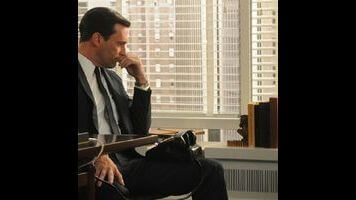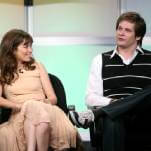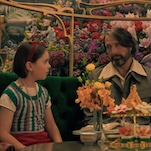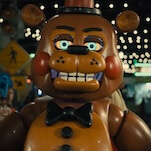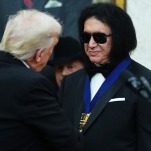The sixth season of Mad Men debuts Sunday night on AMC at 9 p.m. Eastern with a two-hour première. It will air at 10 p.m. Eastern in the weeks following.
“All I’m going to be doing from now on is losing everything,” says a character late in “The Doorway,” the sixth season première of Mad Men, and he could be talking about the show itself, which increasingly feels as if it’s in conversation with its younger self. The first two hours of this new season—the penultimate season of the whole series—are redolent with callbacks to earlier times in the show’s run, filmed in such a way to key memories of who these characters were and where they’ve been in the audience’s mind. But for as much as these men and women seem to move forward, they’re also mostly standing pat. Life is a series of doorways, Roger Sterling opines early on, but after you live long enough, you realize that the more doors you open, the more you recognize what’s on the other side as the same place you were before.
There’s perhaps no better show on television than Mad Men at using the tiny items and objects people accrue in life to signify the places they’ve been, the people they’ve known, and the memories they have. This has always been a strength of the show, even in its earliest going. (Think of how that chip and dip—in the series fourth episode!—came to stand in for all of Pete’s uncertainty about his newly married life, among a host of other things.) But the longer the show goes on, the more death-haunted it becomes, the more it seems as if these objects become stand-ins of another sort—for lives that these people could have led but didn’t, for all of the happiness they lack. Betty Francis finds a musical instrument that belonged to someone she knows and is told she should learn to play it, but she rejects that idea. The Betty who might have done that long ago disappeared, washed away in the unhappiness of her marriage to Don Draper.
It is all but impossible to talk about “The Doorway” in specifics, thanks to a lengthy memo Mad Men creator Matt Weiner sent out to critics forbidding us from mentioning particular story points, suggesting it would spoil the viewing experience for the show’s fans. (Some of the things Weiner doesn’t want spoiled are so obscure and seemingly inconsequential that I now wonder if I’ve been spoiled on the future direction of the season, and it will be interesting to dig the memo out once the season’s over and see if he was just throwing out red herrings.) Suffice to say that the majority of the characters still work in advertising, that Don Draper is still one of the most fascinatingly opaque men on television, and that Peggy Olson has learned a lot from her old mentor in her new job. Things may be largely “the same,” but that’s only because change on Mad Men, as in life, is incremental. To look back at these people in season one is to see just how much the intervening years have changed them, and the shifts in some cases are genuinely startling. (Well, Harry Crane will always be the butt of everybody’s jokes. That will never change.)
The première has less of a “checking in” feeling that many of the show’s other first episodes have had, though the major players all drop in for at least a line or two. It is, by and large, an episode driven by Don, Peggy, Betty, and Roger, and it feels almost fitting to return to these four characters, since they (along with Pete Campbell) were at the center of the show’s original premise, before it started sprouting limbs and characters like Joan started taking on lives of their own. Like last year’s two-hour première, it’s largely one story, though Roger gets a self-contained story in the second hour that offers some of John Slattery’s finest acting on the show. What’s most striking is the way the show uses old images from its past to suggest how the characters have and haven’t evolved out of those old contexts. I suggested in my TV Club 10 piece on the show that as it has gone on, Pete has aged up into Don, Don into Roger, and Roger into Bert (with Bert acting as some sort of unkillable Zen guru), and that’s never felt more appropriate than in “The Doorway,” as these people realize how much they’ve changed (if not necessarily grown) and, indeed, begin losing things they once held dear.
To say much more would be to get too far into the specifics Weiner holds so precious, and it’s easy to see why he feels as he does. Watching Mad Men is often about the experience of watching Mad Men, about seeing the period detail unfold before your eyes or about hearing one of Roger’s great one-liners or about watching Don or Peggy find their way out of a dark corner into a brilliant pitch that almost satisfies a client—if only there could be a picture of the product in it! Weiner’s concerns about plot seem strange to me, because Mad Men is often an almost plotless show, content to simply explore how its characters react to the world shifting around them, but in watching “The Doorway,” I started to get what he meant. To tell you what year this takes place in—or even what time of year it takes place at (though AMC’s promo photos have spoiled that)—would be to rob you of the intoxicating sense of escape and malaise Mad Men brews so easily and handily with each and every episode.
Like most Mad Men season premières, “The Doorway” can be a little slow and ponderous as it shifts all of the pieces into place, suggesting the way this will all play out. There are several new characters—including one played by Lone Star refugee James Wolk—and while it will be interesting to see how they fit into the overall tapestry in weeks to come, Mad Men has never quite figured out how to escape that very basic television problem of having someone show up and act as if they’ve always been important to the plot when the audience knows, in point of fact, that they haven’t. The death imagery—even in the wake of Lane’s suicide at the end of last season—has grown even more potent, to the point where the series seems even more indebted to its spiritual forebear The Sopranos, and this sort of symbolism has tripped up the show in the past and does a few times here. Though Betty is better integrated than she has been the last two seasons, she’s still a character the show’s writers sometimes seem to delight in making a little too awful (though she gets several chances to be enormously sympathetic in the second hour), and the storytelling can be too oblique, as in an opening shot that takes a while to reveal its purpose, then still isn’t immediately clear after that.
But no matter. This is still one of TV’s best shows, still moving confidently and at the height of its powers, filled with great characters and terrific storytelling. It’s been on the air long enough now to have a rich, complicated history of its own, and watching it all spool out—both as it happened and in the changed visages of the characters—continues to be one of TV’s chief pleasures. And always there are those objects and items, ghosts and totems of lives that once were. A cigarette lighter. A piece of office decoration that reminds one of sadly departed Lane. A copy of Dante’s Inferno. A set of skis. A seemingly non-descript Mason jar. Mad Men has always been about the relentless march of history, about the way that time waits for no man. Increasingly, though, it’s taking advantage of its own history, something that gives it a richness and depth most shows on TV barely even aspire to. And at its center are some of the greatest characters in TV history, always plodding through history, eyes averted from a world ripping apart in front of them.
You’ve read my pre-air review; now, here are 10 things I think about “The Doorway,” in detail.
- The best thing about this episode is how it shows just how much Peggy has learned from working with Don all those years. Her final idea to save the headphones Super Bowl ad (and was the Super Bowl that big of a deal in 1967-68?) was a very Draper-esque way to pull a victory out of a defeat, and the way she pushes her staff—sometimes too hard, to the degree where they don’t leave on New Year’s Eve, even though she assumes they will—is reminiscent of how Don treated his greatest protégé as well. She’s learned more from him than just how to be a great ad creative.
- Since Don was lost to fits of anomie throughout—I don’t believe he speaks outside of voiceover until he meets PFC Dinkins in the hotel bar—tonight’s storylines really revolved around some of the characters who can get lost in the shuffle, with Betty’s search for Sandy the violin prodigy and Roger’s delayed grief over his mother both taking up substantial amounts of time. Fortunately, both storylines were good, and I particularly liked the way that Roger’s grief took such a long time in showing and only expressed itself after the dead shoe-shine man’s family left Roger his kit. This was already a show that was filled with foreboding and death imagery, but “The Doorway” cranks that up significantly.
- The spoiler Weiner most wanted us avoiding telling any of you was, of course, that Don has begun cheating on his wife again, this time with a doctor’s wife played by Linda Cardellini (who’s always nice to see). This was probably inevitable—and I never once thought that last season’s “cliffhanger” would result in Don saying anything other than, “Yes, I’m alone”—but the episode is so interested in Don’s inner being that it never once matters until the very end. (Also good: Don’s resolution is to end the affair, even though the both of them know that won’t happen.) I also liked the image of the heart surgeon trudging off through the falling snow to the hospital. (The characters are also very excited by the prospect of heart transplants, one of those period details that really would creep into the characters’ world view, since they all have to be concerned about their hearts.) Megan, meanwhile, is a villain on a soap opera, which seems almost a subtle comment on how some of the fanbase read the character last season.
- Don’s pitch to the hotel people was great, and I also loved how he couldn’t see how it could be read as being about suicide. (Stan thinking that’s what made it awesome was also hilarious.) In general, this episode required Jon Hamm to act befuddled a lot, and that’s something he does well. My favorite instance of this was when the photographer captures a shot of him looking lost after he’s realized that he grabbed Dinkins’ lighter by mistake. (Vietnam hangs more heavily over this episode than maybe any episode of the series and appropriately so.) As a side note: Could you determine if Dinkins ended up with Dick’s lighter or with Don’s? I talked with Alan Sepinwall about this, and neither of us could tell, but sometimes things are harder to make out on screeners than in HD. (My guess, given Don’s demeanor, is that it’s Dick’s lighter, but I wouldn’t be surprised either way.)
- Betty making the goulash for the hippies was a nicely tender moment for the character, and I found myself hoping she would take the violin with her and learn to play it, no matter how much that might have felt like a television device. I also like that the show is treating her weight loss realistically. She hasn’t taken off all of her weight yet, and she’s struggling to do so. (I’m also certain that you’ll all have plenty to say about her very strange pillow talk with her husband about how she’d be happy to hold Sandy down so he could rape her. This is, apparently, her idea of spicing it up.)
- Sally’s fully into her teenage years now, and her complete lack of caring about anything Betty’s talking about wasn’t overdone while still feeling spot on. I liked when she asked Betty to take her to the movies, completely ignoring Betty’s obvious consternation over Sandy’s disappearance. (Also good: “What happened to you?!” in response to Betty dying her hair.)
- The most significant development may be that everybody’s grown weird facial hair and/or sideburns. Stan has an awesome beard. Ginsburg has a mustache. Even Abe’s hair is more all over the place than it was before. (Also great: Peggy’s little smile as she watches him rock out to his album while she’s working.)
- Peggy’s phone manner remains one of the highlights of the series. Her conversation with the minister was all on her end, but it was obvious what he was saying just from the dialogue and how Elisabeth Moss played it. I loved the whole thing ending with, “And also with you.”
- As mentioned in the review, it’s hard to know what James Wolk’s character is supposed to be all about, though it’s obvious that this is going to be an important part of the season (or maybe it will just fizzle out like Nora Zehetner’s nurse character in season four). I liked that it gave Ken Cosgrove a chance to get tough, because Ken Cosgrove is one of the least convincing tough guys ever.
- The scene at Roger’s mother’s funeral was the best of the episode for me. It had everything from Harry getting turned on by Roger’s daughter (and Pete and Ken’s reaction to same) to Don throwing up to some of the most awkward small talk ever. Oh, and also Bert Cooper gliding through life like a particularly proud steamship.
I am looking forward to these next 12 weeks. Welcome to Mad Men, season six!
